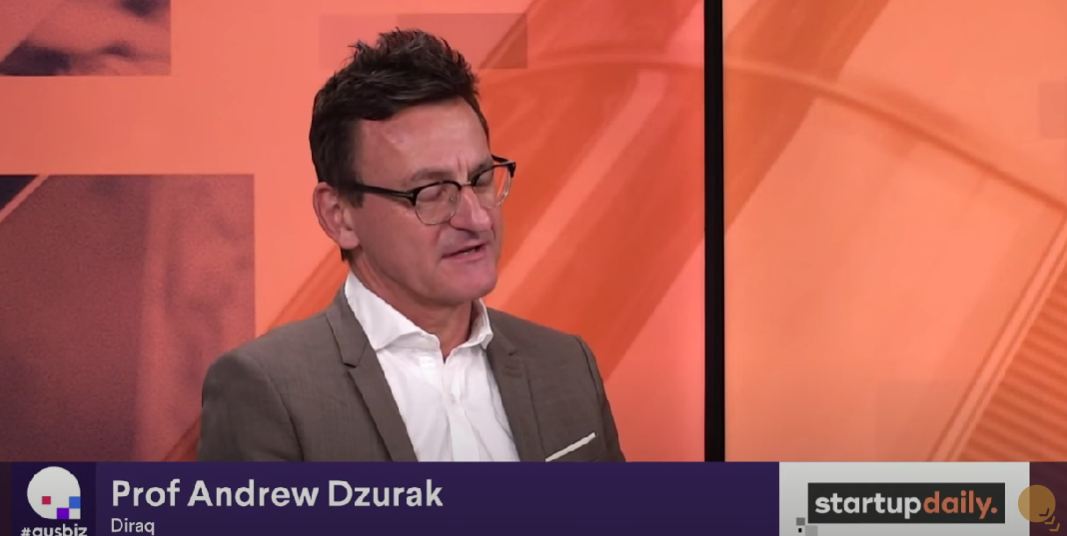Diraq
Diraq is one of the most exciting quantum computing (QC) startups in Australia, if not the world. Coming out of stealth last year as a UNSW Sydney spinoff, the quantum computing company has been developing research into building quantum processors using electron spins in CMOS quantum dots over the last two decades.
Led by its CEO and Founder Andrew Dzurak, the Scientia Professor in Quantum Engineering at UNSW Sydney, as well as an ARC Laureate Fellow and a Member of the Executive Board of the Sydney Quantum Academy — who in 2015 was part of the team that built the first quantum logic is in silicon — recently sat down for an interview at the Startup Daily to discuss spin qubits and a novel approach to control qubits at the scale required for useful QC.
Spinoff
“Well, our company was spun out of the University of New South Wales in May last year, and we’re focused on building full-scale quantum computers to tackle problems in big pharma, in defence, in finance, and also in climate change and so on,” said Dzurak, before mentioning Diraq is focused on reaching millions of qubits. “At the moment,” he continued, “there’s a number of competing technologies all around the world, from some big companies like IBM and Google, but also a number of startups that have started here in Australia and all around the world.”
But what does this all mean for the future of the sector?

“So, the approach that we’ve taken with Diraq is that about a decade ago, we showed that we could take the transistors that we have on standard silicon chips that we have in our phone or laptop and change them into quantum bits of information and operate them to make a quantum processor chip,” said Dzurak.
These gates, Dzurak went on, are the so-called logic gates that do the processing, in a way on a standard chip.
“We have gates that perform operations to do data processing. On a quantum processor chip, things are a little bit more complicated, but in the end, the thing just looks like a chip. And the focus of Dirac is to use that same technology, and to get many millions of them on a chip because that’s what you need in order to address the sort of problems I was talking about like drug design, financial modelling, and so on,” said Dzurak.
Dzurak also noted to put it in context, now the most advanced quantum computers in the world have less than 100 quantum bits. Diraq’s founder claims you need to be up in the millions if the industry is going to get to those really valuable applications.
“Flipped”
The interviewer mentioned that magnetic fields have been the traditional way to do things, but Diraq has “flipped” that by using electric ones.
When asked whether this is a game changer in terms of the future possibilities and ability to leapfrog the numbers, Dzurak’s answer clearly explained the startup’s destination.
“We’ve got a technical roadmap that’s been designed to get us to millions of qubits within a decade,” said Dzurak, “so to really get that massive value out of quantum computing. And at the moment, our roadmap assumes we’re going to use magnetic fields. What this opens up with the new discovery that we published a couple of weeks ago,” he went on, “is it provides a potential shortcut on that roadmap that could shave off a couple of years and potentially a significant amount of investment.”
Dzurak also said some very significant investments for CHIP foundries need to be made to develop these chips, though the actual costs involved are significant because Diraq uses the same chip foundries that are used to make the processor chips in laptops and phones.
“It’s an expensive business, and we’re trying to reduce the cost of that development. So one of the key benefits of this new way of operating the qubits is that we can make it simpler and potentially cheaper to make,” said Dzurak.
Timeframes were next on the agenda, and if the startup is talking years or decades on how quickly its technology can move the sector forward.
“So, the first thing to understand is that there are already companies that are selling access to early-stage quantum computers, which are just say fifty to 100 qubits, right?” said Dzurak. “Already big corporations are paying to play with those. We’re looking to have online cloud-accessible systems within three years, where people are going to be able to work and develop new algorithms and new ideas with quantum computers within a decade. In fact, in six years, we’re looking to be making your first one million qubit chips. And that immediately opens up very significant value, both from a point of view of sales of hardware, but also access through the cloud.”
Investment is always an issue. What plans does the UNSW spinoff have up its sleeve here?
“When we spun out, we had a significant series A investment of over $20 million AUD and at the moment, we’re looking at essentially an A2 to bridge us for the next few years to complete the first phase of our technical roadmap. That’s going to get our first chips made in a tier-one foundry in the US and potentially Europe. So, that will allow us to expand our local team in Sydney and get the technology transfer from what we’ve done in Australia into manufacturing chip plants overseas,” said Dzurak.
When the question as to whether he still has those moments with breakthroughs, when the theory becomes reality, Diraq’s founder said he is in an extremely fortunate position in that he is working on a fantastic connection between the business world and commercial world, but also he gets to see the excitement in the lab.
Serendipity
“So you know, this result, as it turns out, wasn’t something we’d been driving to,” said Dzurak. “It was a serendipitous discovery about a year ago. It was completely out of left field. We never expected it, but it can create a great shortcut. When we realized what it was, I mean, lots of excitement in the lab. I still get very, very excited.”
No one can stress enough how important R&D is, especially in the hard tech field that is QC. The interviewer highlighted how crucial funding is to the sector, a sector that even New South Wales, the federal government and investors are very keen to find out what’s happening.
“The thing you know, Dirac is a twenty-five-year overnight success. I mean, you hear this all the time, right?” Dzurak began. “That we developed a stack of IP of over forty patents that are now globally lodged in ten patent families that were built up over fifteen to twenty years of research, funded through the Australian Research Council.”
Dzurak informed his interlocutor that Diraq also gets a lot of money from the US Army Research Office.
“It’s been research grants at university that have allowed us to have that initial basic research going on in universities in order to build up the technology to have something commercial,” said Dzurak, adding that fortunately in quantum, as it turns out, the Australian Government and the New South Wales government actually placed bets twenty years before on quantum — bets that today are really “bearing fruit”.
“I mean, at the moment we have one of the most thriving quantum ecosystems anywhere in the world right here in Sydney,” Dzurak added.
If you found this article to be informative, you can explore more current quantum news here, exclusives, interviews, and podcasts.


















